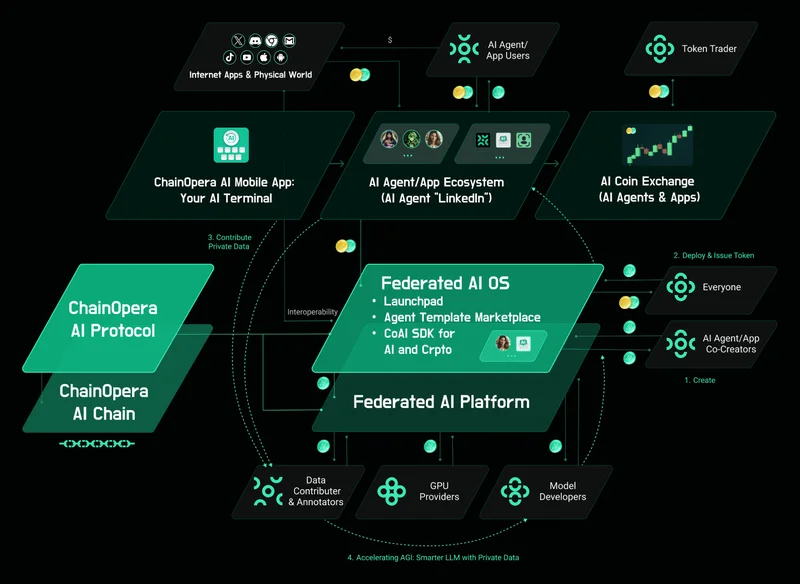Of all the signals I watch for in the ever-shifting landscape of technology, the most telling isn't a price chart or a venture capital funding announcement. It's the sound of a debate reaching a fever pitch. It's that chaotic, beautiful moment when a new idea is so potent, so disruptive, that the world can't decide if it's a scam or a salvation. Right now, that sound is deafening, and it’s all centered around a project called ChainOpera AI.
You’ve probably seen the headlines. A 2,200% surge in 30 days. A fully diluted valuation that shot past $4 billion. Daily trading volumes eclipsing giants like Solana and BNB. These are numbers that force you to pay attention. But then, you see the other side. The whispers and then the shouts: "scam," "centralized," "another crypto flameout." One analyst I read dismissed it as a "fake product with a made-up AI story."
And this is where I think most people are getting it wrong. They’re asking the wrong question. They’re asking, "Should I buy COAI?" When the real, the far more fascinating question is, "What can we learn from the way ChainOpera AI came to be?" Because beneath the volatile price action and the furious debate, I believe we're seeing the beta test of a powerful new playbook for launching projects in the Web3 era.
When I first dug into their strategy, past the noise of the token price, I honestly just sat back in my chair, speechless. This is the kind of breakthrough that reminds me why I got into this field in the first place.
The Real Innovation Isn't Code, It's Community
For years, the great, unsolved problem in the blockchain world has been the chasm between users and holders. You have one group of people who use a platform and another, entirely separate group who speculates on its token. ChainOpera AI didn't just acknowledge this problem; they engineered a solution. They built a funnel from product users to token holders—in simpler terms, they made sure the people using the thing were the same people investing in it.
Think about that for a moment. They quietly built an ecosystem with a suite of AI products, attracting a staggering 3 million users. Of those, 300,000 started using the BNB chain to access the services. And from that dedicated, engaged group, 40,000 converted into actual token holders right after the launch. This isn't just a marketing tactic; it's a fundamental paradigm shift.

It's like a musician who spends a year performing free concerts, building a massive, loyal following on the ground, and only then releases their debut album. They aren't selling to consumers; they're empowering evangelists. The community isn't an afterthought; it's the entire foundation. Is it any wonder, then, that when the token launched, the social media mentions exploded by 1,308% in a single day? The fire was already lit; the token was just the gasoline.
Now, we have to be clear-eyed about the risks. The reports of high wallet centralization—with some claiming ten wallets hold nearly 88% of the supply—are not something to be dismissed. These concerns are a major reason Why Are Experts Calling ChainOpera AI (COAI) a Scam?. This is the critical moment of ethical consideration for any project that follows this path. How do you ensure that empowering a community doesn't accidentally become enriching a small few? True decentralization must be the goal, not just a marketing buzzword.
An Orchestra of Timing in a World of Noise
The other piece of this puzzle is the almost preternatural sense of timing. The team didn't just build a product and throw it into the void. They waited. They watched. They saw the AI narrative heating up, thanks to early projects that had already educated the market. They saw the BNB ecosystem reaching an absolute fever pitch, with on-chain fees and perpetuals trading volume going through the roof. They even coordinated their launch on the exact same day as another high-profile project to create a "bundle buying" effect—the speed and complexity of this is just staggering, it’s a level of market orchestration we rarely see outside of Wall Street’s most sophisticated players. This strategy is a core part of The Secret Behind ChainOpera AI’s Explosive Success: Strategic Cycle Timing and a Fully Diluted Valuation Beyond $4 Billion.
This is less like a product launch and more like a symphony. Each section—the product development, the community building, the ecosystem choice, the market timing—was brought in at the perfect moment to create a crescendo of momentum. It reminds me of the early days of the Apple App Store. The developers who succeeded weren't always the ones with the absolute best code, but the ones who understood the platform's dynamics. They knew how to get featured, how to ride the waves of user interest, and how to use the ecosystem to their advantage. ChainOpera AI seems to have understood the "BNB App Store" on an instinctual level.
So, what does this all mean for us? It means the game is changing. The era of launching a whitepaper and a prayer might just be ending. The future may belong to those who build an audience before they build a balance sheet. What if the next great decentralized application already has a million dedicated users before its token even exists? What kind of stability and long-term vision could that enable?
The Conversation Has Changed
Forget the price for a second. The real, lasting value of ChainOpera AI might not be in its token, but in its strategy. It has provided a public, high-stakes case study on bridging the gap between utility and ownership. Whether it ultimately succeeds or fails, it has forced a new conversation. It has shown a different way. And for anyone building in this space, that blueprint—that change in perspective—is worth more than any all-time high. The future is arriving, and it looks a lot more like a community than a corporation.









